Essay on the Effects of Corporal Punishment on Children
VerifiedAdded on 2022/10/12
|8
|1550
|338
Essay
AI Summary
This essay examines the concept of corporal punishment, defining it as the intentional application of physical force to cause harm or discomfort as a form of discipline. It explores the negative impacts of such practices on children's psychosocial, emotional, and cognitive development. The essay highlights the stance of the United Nations and legal frameworks like CAPTA and the Criminal Code of Canada, which address child abuse and corporal punishment. It discusses the psychological effects, including trauma, depression, and aggression, and provides recommendations for parents, agencies, and pediatricians to foster healthier child development through anticipatory guidance, parental education, and community resources. The essay emphasizes the importance of alternative disciplinary methods and the need for a supportive environment for children.

Running Head: CORPORAL PUNISHMENT AND CHILDREN
CORPORAL PUNISHMENT AND CHILDREN
Name of the Student
Name of the University
Author Note
CORPORAL PUNISHMENT AND CHILDREN
Name of the Student
Name of the University
Author Note
Paraphrase This Document
Need a fresh take? Get an instant paraphrase of this document with our AI Paraphraser

1CORPORAL PUNISHMENT AND CHILDREN
Speech Title: Discipline by force
Specific Purpose: To venture the need and effect of Corporal punishments
in present times
Introduction:
A. What is Corporal punishment? Who can help?
The intentional application of any physical force in order to cause harm, pain or
discomfort as a measure or kind of punishment for one’s behavior that is unacceptable is
known as corporal punishment. Pediatricians play a key role in guiding parents and
teachers to develop a proper behavioral approach, which is effective in disciplining a
child across ages. Corporal punishments like shaming or spanking a child in the public
has a negative impact on the psychosocial, emotional and cognitive development of the
child.
B. Background:
The United Nations (UN) Convention on the child rights has long banned the use of
any form of corporal punishment to change child behavior. This includes hitting, like
slapping, smacking, spanking, kicking, pinching, pulling hair or ear(s) by force or
even using an implement like a belt, wooden spoon, stick, whip, or similar for
inflicting any form of physical punishment. Such behaviors inflicted on children during
their growing ages can have negative effect on teenagers during their adolescence. Public
shaming or verbal abuse might even push to depression and mistrust in their close ones,
like parents, family or teachers.
Speech Title: Discipline by force
Specific Purpose: To venture the need and effect of Corporal punishments
in present times
Introduction:
A. What is Corporal punishment? Who can help?
The intentional application of any physical force in order to cause harm, pain or
discomfort as a measure or kind of punishment for one’s behavior that is unacceptable is
known as corporal punishment. Pediatricians play a key role in guiding parents and
teachers to develop a proper behavioral approach, which is effective in disciplining a
child across ages. Corporal punishments like shaming or spanking a child in the public
has a negative impact on the psychosocial, emotional and cognitive development of the
child.
B. Background:
The United Nations (UN) Convention on the child rights has long banned the use of
any form of corporal punishment to change child behavior. This includes hitting, like
slapping, smacking, spanking, kicking, pinching, pulling hair or ear(s) by force or
even using an implement like a belt, wooden spoon, stick, whip, or similar for
inflicting any form of physical punishment. Such behaviors inflicted on children during
their growing ages can have negative effect on teenagers during their adolescence. Public
shaming or verbal abuse might even push to depression and mistrust in their close ones,
like parents, family or teachers.
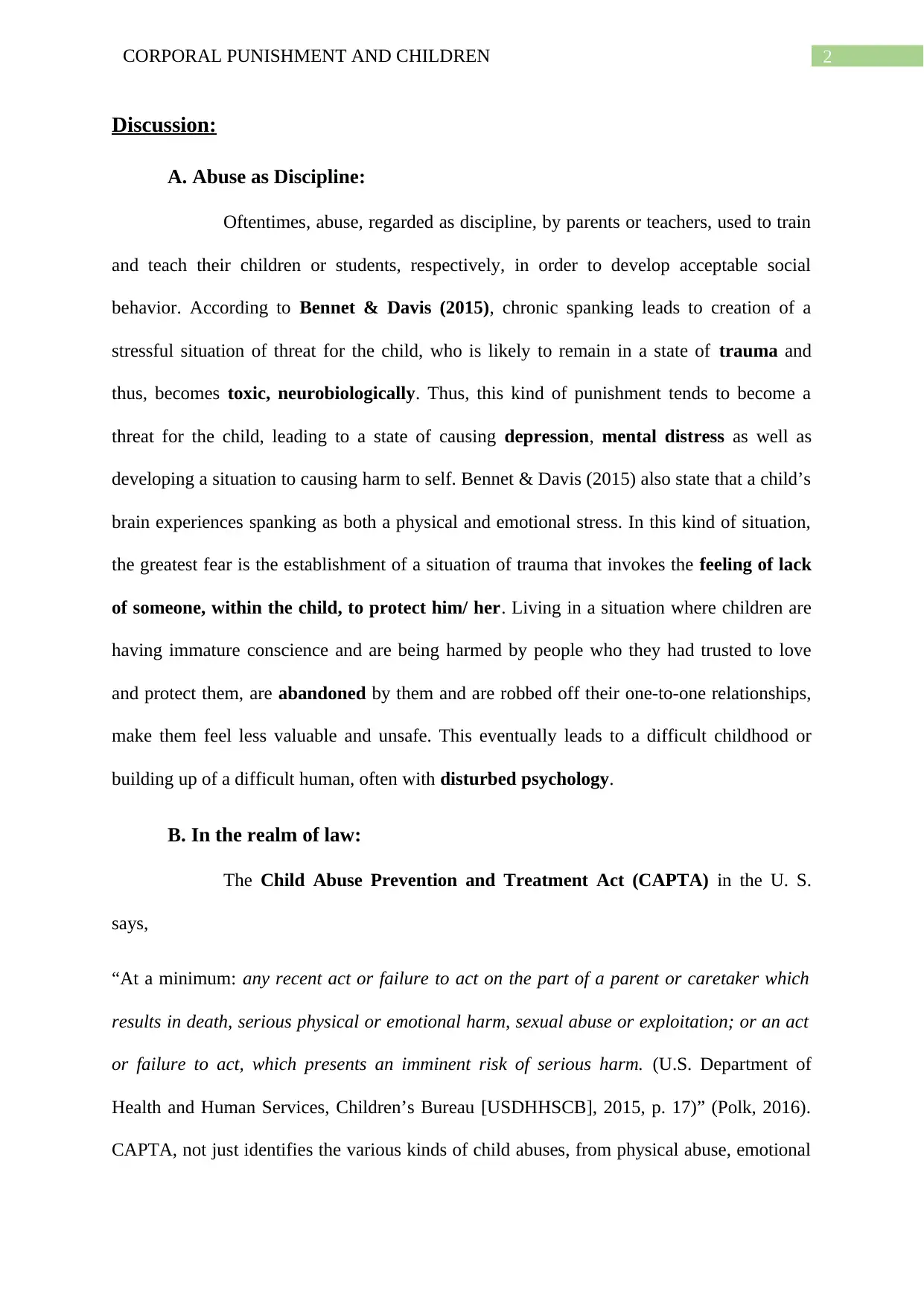
2CORPORAL PUNISHMENT AND CHILDREN
Discussion:
A. Abuse as Discipline:
Oftentimes, abuse, regarded as discipline, by parents or teachers, used to train
and teach their children or students, respectively, in order to develop acceptable social
behavior. According to Bennet & Davis (2015), chronic spanking leads to creation of a
stressful situation of threat for the child, who is likely to remain in a state of trauma and
thus, becomes toxic, neurobiologically. Thus, this kind of punishment tends to become a
threat for the child, leading to a state of causing depression, mental distress as well as
developing a situation to causing harm to self. Bennet & Davis (2015) also state that a child’s
brain experiences spanking as both a physical and emotional stress. In this kind of situation,
the greatest fear is the establishment of a situation of trauma that invokes the feeling of lack
of someone, within the child, to protect him/ her. Living in a situation where children are
having immature conscience and are being harmed by people who they had trusted to love
and protect them, are abandoned by them and are robbed off their one-to-one relationships,
make them feel less valuable and unsafe. This eventually leads to a difficult childhood or
building up of a difficult human, often with disturbed psychology.
B. In the realm of law:
The Child Abuse Prevention and Treatment Act (CAPTA) in the U. S.
says,
“At a minimum: any recent act or failure to act on the part of a parent or caretaker which
results in death, serious physical or emotional harm, sexual abuse or exploitation; or an act
or failure to act, which presents an imminent risk of serious harm. (U.S. Department of
Health and Human Services, Children’s Bureau [USDHHSCB], 2015, p. 17)” (Polk, 2016).
CAPTA, not just identifies the various kinds of child abuses, from physical abuse, emotional
Discussion:
A. Abuse as Discipline:
Oftentimes, abuse, regarded as discipline, by parents or teachers, used to train
and teach their children or students, respectively, in order to develop acceptable social
behavior. According to Bennet & Davis (2015), chronic spanking leads to creation of a
stressful situation of threat for the child, who is likely to remain in a state of trauma and
thus, becomes toxic, neurobiologically. Thus, this kind of punishment tends to become a
threat for the child, leading to a state of causing depression, mental distress as well as
developing a situation to causing harm to self. Bennet & Davis (2015) also state that a child’s
brain experiences spanking as both a physical and emotional stress. In this kind of situation,
the greatest fear is the establishment of a situation of trauma that invokes the feeling of lack
of someone, within the child, to protect him/ her. Living in a situation where children are
having immature conscience and are being harmed by people who they had trusted to love
and protect them, are abandoned by them and are robbed off their one-to-one relationships,
make them feel less valuable and unsafe. This eventually leads to a difficult childhood or
building up of a difficult human, often with disturbed psychology.
B. In the realm of law:
The Child Abuse Prevention and Treatment Act (CAPTA) in the U. S.
says,
“At a minimum: any recent act or failure to act on the part of a parent or caretaker which
results in death, serious physical or emotional harm, sexual abuse or exploitation; or an act
or failure to act, which presents an imminent risk of serious harm. (U.S. Department of
Health and Human Services, Children’s Bureau [USDHHSCB], 2015, p. 17)” (Polk, 2016).
CAPTA, not just identifies the various kinds of child abuses, from physical abuse, emotional
⊘ This is a preview!⊘
Do you want full access?
Subscribe today to unlock all pages.

Trusted by 1+ million students worldwide
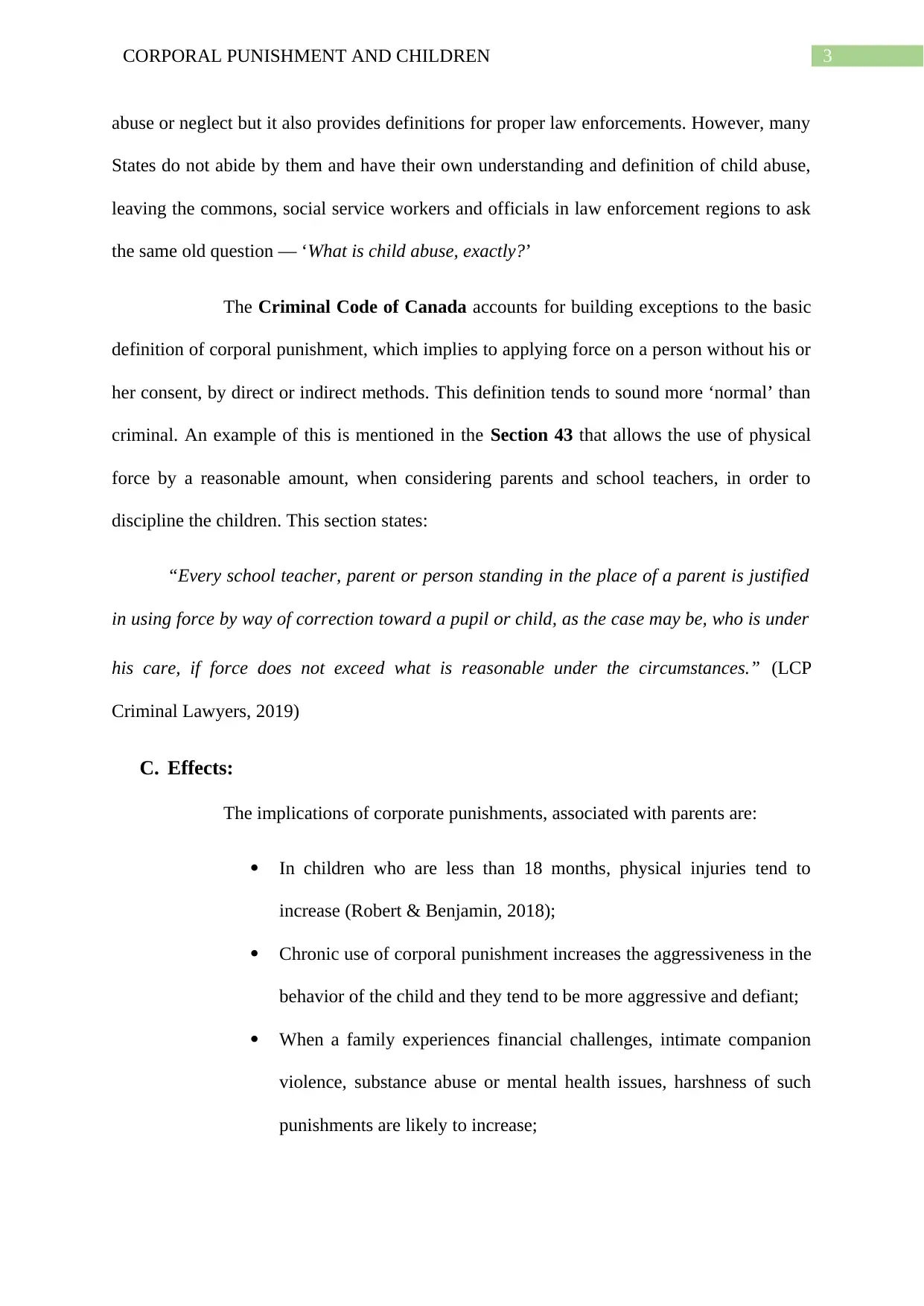
3CORPORAL PUNISHMENT AND CHILDREN
abuse or neglect but it also provides definitions for proper law enforcements. However, many
States do not abide by them and have their own understanding and definition of child abuse,
leaving the commons, social service workers and officials in law enforcement regions to ask
the same old question — ‘What is child abuse, exactly?’
The Criminal Code of Canada accounts for building exceptions to the basic
definition of corporal punishment, which implies to applying force on a person without his or
her consent, by direct or indirect methods. This definition tends to sound more ‘normal’ than
criminal. An example of this is mentioned in the Section 43 that allows the use of physical
force by a reasonable amount, when considering parents and school teachers, in order to
discipline the children. This section states:
“Every school teacher, parent or person standing in the place of a parent is justified
in using force by way of correction toward a pupil or child, as the case may be, who is under
his care, if force does not exceed what is reasonable under the circumstances.” (LCP
Criminal Lawyers, 2019)
C. Effects:
The implications of corporate punishments, associated with parents are:
In children who are less than 18 months, physical injuries tend to
increase (Robert & Benjamin, 2018);
Chronic use of corporal punishment increases the aggressiveness in the
behavior of the child and they tend to be more aggressive and defiant;
When a family experiences financial challenges, intimate companion
violence, substance abuse or mental health issues, harshness of such
punishments are likely to increase;
abuse or neglect but it also provides definitions for proper law enforcements. However, many
States do not abide by them and have their own understanding and definition of child abuse,
leaving the commons, social service workers and officials in law enforcement regions to ask
the same old question — ‘What is child abuse, exactly?’
The Criminal Code of Canada accounts for building exceptions to the basic
definition of corporal punishment, which implies to applying force on a person without his or
her consent, by direct or indirect methods. This definition tends to sound more ‘normal’ than
criminal. An example of this is mentioned in the Section 43 that allows the use of physical
force by a reasonable amount, when considering parents and school teachers, in order to
discipline the children. This section states:
“Every school teacher, parent or person standing in the place of a parent is justified
in using force by way of correction toward a pupil or child, as the case may be, who is under
his care, if force does not exceed what is reasonable under the circumstances.” (LCP
Criminal Lawyers, 2019)
C. Effects:
The implications of corporate punishments, associated with parents are:
In children who are less than 18 months, physical injuries tend to
increase (Robert & Benjamin, 2018);
Chronic use of corporal punishment increases the aggressiveness in the
behavior of the child and they tend to be more aggressive and defiant;
When a family experiences financial challenges, intimate companion
violence, substance abuse or mental health issues, harshness of such
punishments are likely to increase;
Paraphrase This Document
Need a fresh take? Get an instant paraphrase of this document with our AI Paraphraser
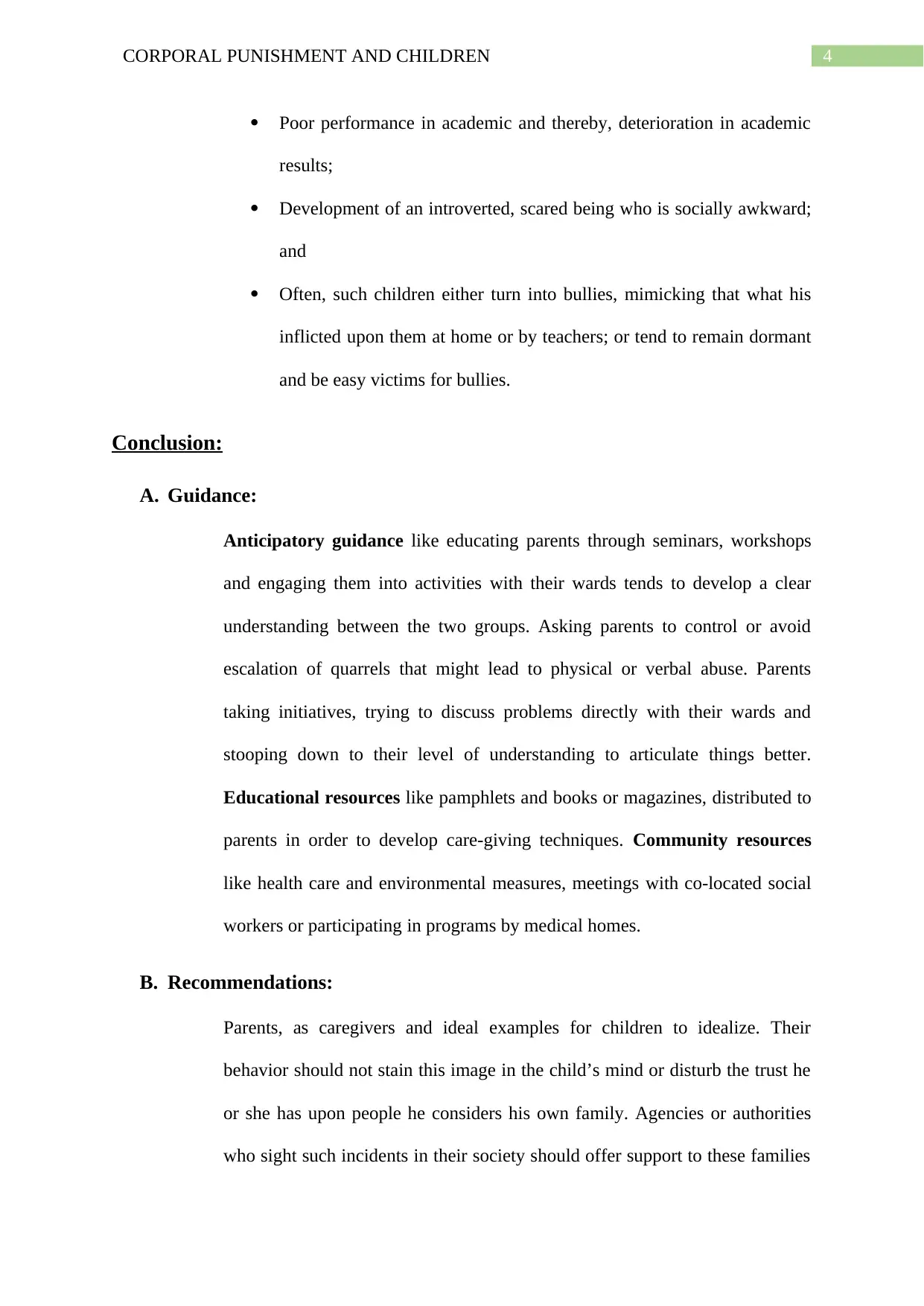
4CORPORAL PUNISHMENT AND CHILDREN
Poor performance in academic and thereby, deterioration in academic
results;
Development of an introverted, scared being who is socially awkward;
and
Often, such children either turn into bullies, mimicking that what his
inflicted upon them at home or by teachers; or tend to remain dormant
and be easy victims for bullies.
Conclusion:
A. Guidance:
Anticipatory guidance like educating parents through seminars, workshops
and engaging them into activities with their wards tends to develop a clear
understanding between the two groups. Asking parents to control or avoid
escalation of quarrels that might lead to physical or verbal abuse. Parents
taking initiatives, trying to discuss problems directly with their wards and
stooping down to their level of understanding to articulate things better.
Educational resources like pamphlets and books or magazines, distributed to
parents in order to develop care-giving techniques. Community resources
like health care and environmental measures, meetings with co-located social
workers or participating in programs by medical homes.
B. Recommendations:
Parents, as caregivers and ideal examples for children to idealize. Their
behavior should not stain this image in the child’s mind or disturb the trust he
or she has upon people he considers his own family. Agencies or authorities
who sight such incidents in their society should offer support to these families
Poor performance in academic and thereby, deterioration in academic
results;
Development of an introverted, scared being who is socially awkward;
and
Often, such children either turn into bullies, mimicking that what his
inflicted upon them at home or by teachers; or tend to remain dormant
and be easy victims for bullies.
Conclusion:
A. Guidance:
Anticipatory guidance like educating parents through seminars, workshops
and engaging them into activities with their wards tends to develop a clear
understanding between the two groups. Asking parents to control or avoid
escalation of quarrels that might lead to physical or verbal abuse. Parents
taking initiatives, trying to discuss problems directly with their wards and
stooping down to their level of understanding to articulate things better.
Educational resources like pamphlets and books or magazines, distributed to
parents in order to develop care-giving techniques. Community resources
like health care and environmental measures, meetings with co-located social
workers or participating in programs by medical homes.
B. Recommendations:
Parents, as caregivers and ideal examples for children to idealize. Their
behavior should not stain this image in the child’s mind or disturb the trust he
or she has upon people he considers his own family. Agencies or authorities
who sight such incidents in their society should offer support to these families

5CORPORAL PUNISHMENT AND CHILDREN
or take help from the bodies like UN and AAP (American Academy of
Pediatrics). Pediatric visits should be made compulsory, every month, to look
into the child’s development. Pediatric visits should be made available in
schools, free of cost or at a subsidized rate, to assess the role of the parents as
well as the development of the child. The association of the State or
government plays an important role in this aspect and development of better
individuals for a nation, free of young offenders (Locher-Lo, 2018).
or take help from the bodies like UN and AAP (American Academy of
Pediatrics). Pediatric visits should be made compulsory, every month, to look
into the child’s development. Pediatric visits should be made available in
schools, free of cost or at a subsidized rate, to assess the role of the parents as
well as the development of the child. The association of the State or
government plays an important role in this aspect and development of better
individuals for a nation, free of young offenders (Locher-Lo, 2018).
⊘ This is a preview!⊘
Do you want full access?
Subscribe today to unlock all pages.

Trusted by 1+ million students worldwide
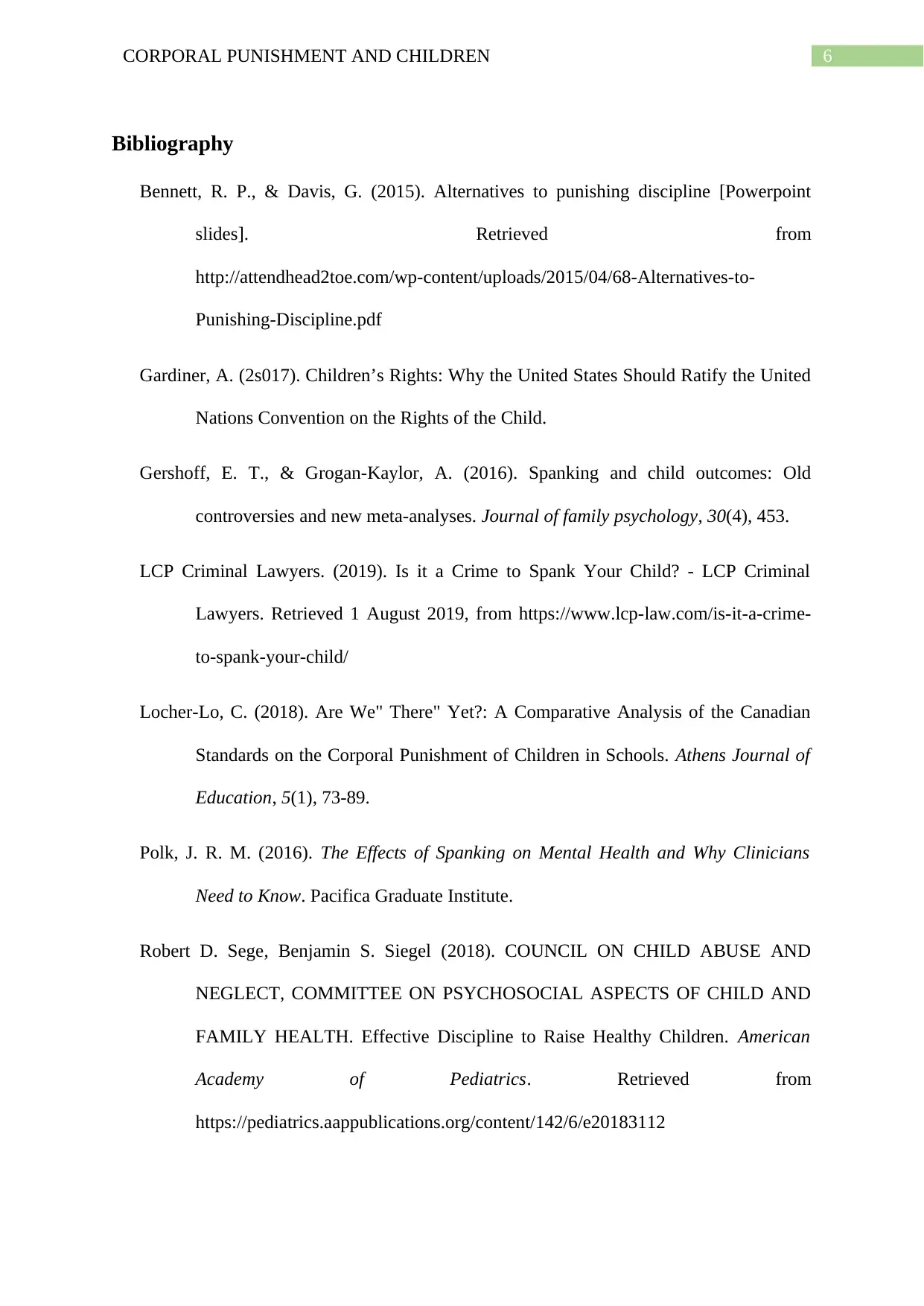
6CORPORAL PUNISHMENT AND CHILDREN
Bibliography
Bennett, R. P., & Davis, G. (2015). Alternatives to punishing discipline [Powerpoint
slides]. Retrieved from
http://attendhead2toe.com/wp-content/uploads/2015/04/68-Alternatives-to-
Punishing-Discipline.pdf
Gardiner, A. (2s017). Children’s Rights: Why the United States Should Ratify the United
Nations Convention on the Rights of the Child.
Gershoff, E. T., & Grogan-Kaylor, A. (2016). Spanking and child outcomes: Old
controversies and new meta-analyses. Journal of family psychology, 30(4), 453.
LCP Criminal Lawyers. (2019). Is it a Crime to Spank Your Child? - LCP Criminal
Lawyers. Retrieved 1 August 2019, from https://www.lcp-law.com/is-it-a-crime-
to-spank-your-child/
Locher-Lo, C. (2018). Are We" There" Yet?: A Comparative Analysis of the Canadian
Standards on the Corporal Punishment of Children in Schools. Athens Journal of
Education, 5(1), 73-89.
Polk, J. R. M. (2016). The Effects of Spanking on Mental Health and Why Clinicians
Need to Know. Pacifica Graduate Institute.
Robert D. Sege, Benjamin S. Siegel (2018). COUNCIL ON CHILD ABUSE AND
NEGLECT, COMMITTEE ON PSYCHOSOCIAL ASPECTS OF CHILD AND
FAMILY HEALTH. Effective Discipline to Raise Healthy Children. American
Academy of Pediatrics. Retrieved from
https://pediatrics.aappublications.org/content/142/6/e20183112
Bibliography
Bennett, R. P., & Davis, G. (2015). Alternatives to punishing discipline [Powerpoint
slides]. Retrieved from
http://attendhead2toe.com/wp-content/uploads/2015/04/68-Alternatives-to-
Punishing-Discipline.pdf
Gardiner, A. (2s017). Children’s Rights: Why the United States Should Ratify the United
Nations Convention on the Rights of the Child.
Gershoff, E. T., & Grogan-Kaylor, A. (2016). Spanking and child outcomes: Old
controversies and new meta-analyses. Journal of family psychology, 30(4), 453.
LCP Criminal Lawyers. (2019). Is it a Crime to Spank Your Child? - LCP Criminal
Lawyers. Retrieved 1 August 2019, from https://www.lcp-law.com/is-it-a-crime-
to-spank-your-child/
Locher-Lo, C. (2018). Are We" There" Yet?: A Comparative Analysis of the Canadian
Standards on the Corporal Punishment of Children in Schools. Athens Journal of
Education, 5(1), 73-89.
Polk, J. R. M. (2016). The Effects of Spanking on Mental Health and Why Clinicians
Need to Know. Pacifica Graduate Institute.
Robert D. Sege, Benjamin S. Siegel (2018). COUNCIL ON CHILD ABUSE AND
NEGLECT, COMMITTEE ON PSYCHOSOCIAL ASPECTS OF CHILD AND
FAMILY HEALTH. Effective Discipline to Raise Healthy Children. American
Academy of Pediatrics. Retrieved from
https://pediatrics.aappublications.org/content/142/6/e20183112
Paraphrase This Document
Need a fresh take? Get an instant paraphrase of this document with our AI Paraphraser
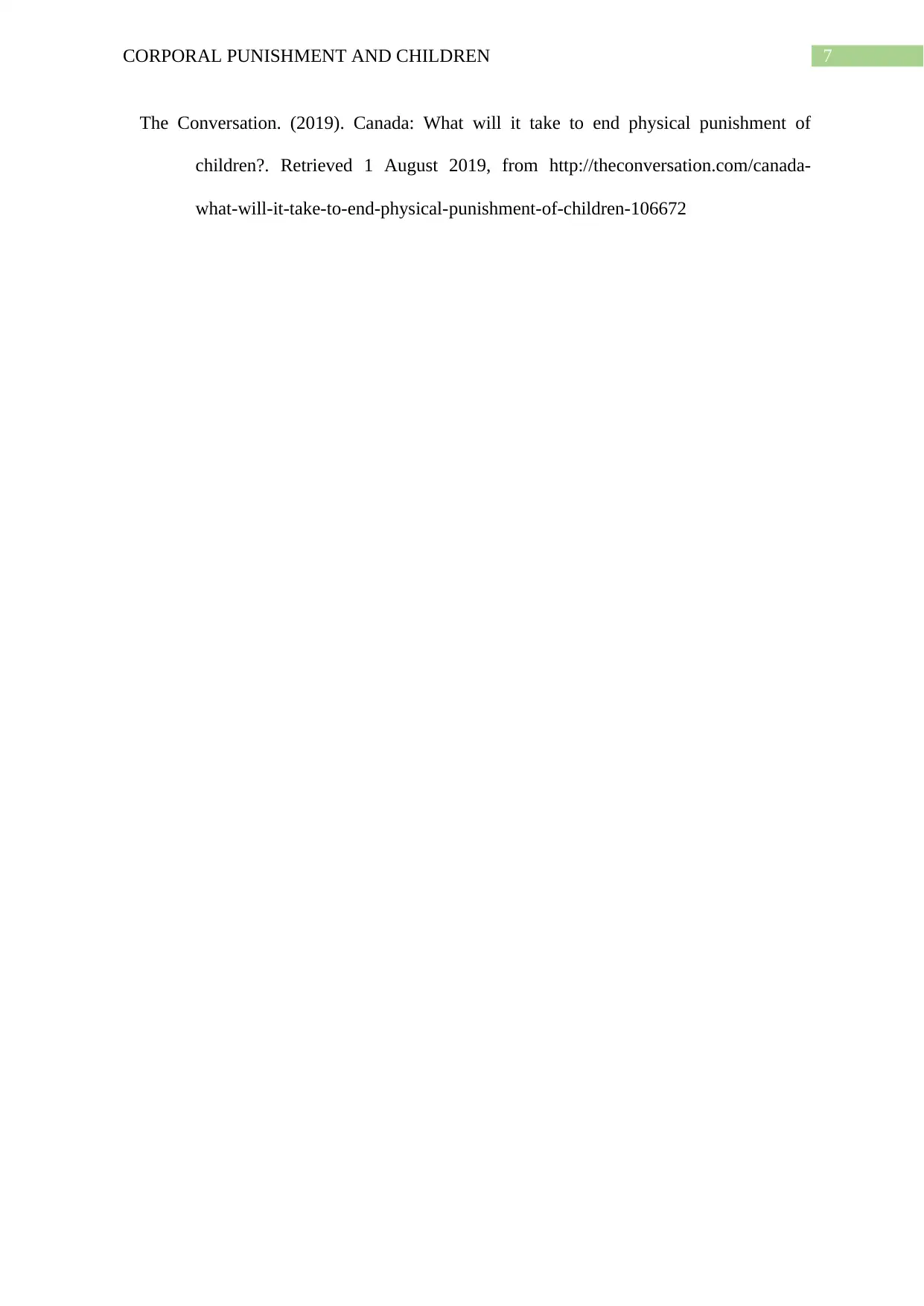
7CORPORAL PUNISHMENT AND CHILDREN
The Conversation. (2019). Canada: What will it take to end physical punishment of
children?. Retrieved 1 August 2019, from http://theconversation.com/canada-
what-will-it-take-to-end-physical-punishment-of-children-106672
The Conversation. (2019). Canada: What will it take to end physical punishment of
children?. Retrieved 1 August 2019, from http://theconversation.com/canada-
what-will-it-take-to-end-physical-punishment-of-children-106672
1 out of 8
Related Documents
Your All-in-One AI-Powered Toolkit for Academic Success.
+13062052269
info@desklib.com
Available 24*7 on WhatsApp / Email
![[object Object]](/_next/static/media/star-bottom.7253800d.svg)
Unlock your academic potential
Copyright © 2020–2025 A2Z Services. All Rights Reserved. Developed and managed by ZUCOL.




